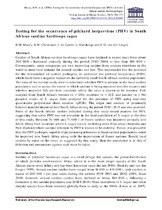Testing for the occurrence of pilchard herpesvirus (PHV) in South African sardine Sardinops sagax
Date
2016Author
Macey, B.M.
Christison, K.W.
de Goede, J.
Hutchings, L.
van der Lingen, C.D.
Metadata
Show full item recordAbstract
Catches of South African sardine Sardinops sagax have declined in recent years from about 200 000 t harvested annually during the period 2002–2006 to less than 100 000 t. Consequently, some companies are now importing sardine from sources elsewhere in the world to meet local demand for canned sardine and bait. This importation has the potential for the introduction of sardine pathogens, in particular the pilchard herpesvirus (PHV), which could have a negative impact on the currently small South African sardine population. The aims of the current study were to determine whether PHV is present in the local sardine population and to assess the extent to which sardine is being imported into the country and whether imported fish are from countries where the virus is known to be endemic. Fish sampled from South Africa’s western (n = 150), southern (n = 182) and eastern (n = 96) putative stocks of S. sagax were analysed for the presence of PHV using real-time quantitative polymerase chain reaction (qPCR). The origin and amount of potentially infected material imported into South Africa during the period 2010–2014 was also assessed. None of the South African sardine collected during this study tested positive for PHV, suggesting that active PHV was not prevalent in the local population of S. sagax at the time of this study. Between 56 000 and 71 000 t of frozen sardine was imported annually into South Africa from countries where S. sagax occurs, including some from areas (Australia and New Zealand) where sardine infection by PHV is known to be endemic. Hence, it is plausible that the PHV pathogen, capable of perpetuating infections in local sardine populations, could be imported into South Africa along with the importation of frozen sardine. Should local sardine be naïve to the virus, as suggested by this study, then the population is at risk of infection and precautions against such must be taken.

